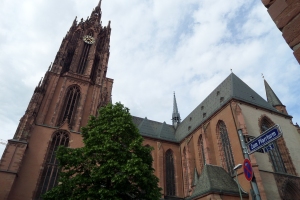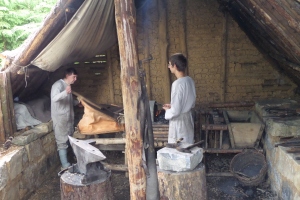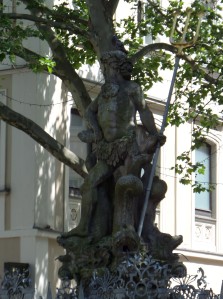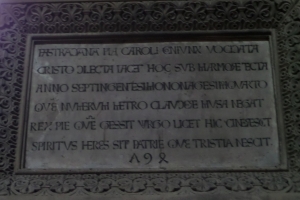This blog has been dormant for far too long. So long, in fact, that I’m surprised my account had not been terminated a year ago! So I’ve been trying to think of ways to get back into writing for it. Almost all of the advice I’ve heard for how to write more is basically “just write more”…
…
…
but my problem is having something to write about. First I need to do the work that leads to writing. Soon, I promise, that will happen.
In the meantime, I thought about maybe sharing something else. The blog’s title, after all, is “Mostly Medieval,” so I’ll take liberty with the “mostly” bit today. What I have for you is the written version of a lecture I delivered to our Scholars Seminar in January 2017. I did the lecture for the seminar, and because I was running the seminar didn’t do anything else with it at the time. But as I thought about resurrecting this blog, it dawned on me that I had this sitting right in front of me. It would be so easy just to edit this and post it.
That semester, the Scholars Seminar was devoted to Star Wars as a cultural phenomenon, and I opened the semester with an overview of the story of the first six movies and some interesting thoughts about how the story relates to earthling history. What follows is pretty much what I did in the lecture, except here you don’t get to see the cool Star Wars Screen Crawl with music that I opened with. It was epic. Whether you’re a lifelong fan of the movies or not, I hope you can spare a few minutes and give this a read.
My Opening Bit
First, how about this bit from an article in the Chronicle of Higher Education that I read late last week: “How to Cultivate Faculty Leaders” January 15, 2017 (I read it a few days later [apologies if it’s behind a paywall for you]). The joke among faculty is that those who move into administrative roles like “associate dean” or something have “gone to the dark side.” Remember last week’s remarks about Star Wars as a cultural phenomenon worthy of our study. This is another way that Star Wars has pretty much infiltrated the culture to the degree of giving us a stock phrase to use.
Overview of the Story, especially helpful for those who are novices, and I kind of feel like I need to apologize to purists in the audience, because this lecture is more about the prequels than the original trilogy. Super duper spoiler warning!
A long time ago in a galaxy far, far away, the inhabitants of many planets came into contact with each other. At some point they established a Galactic Republic to govern their affairs. The leader of the Republic was a chancellor, who worked with the Senate to make laws and regulate their affairs.
By the time the story as shown in the movies actually begins (and I mean Episode I), we see a couple of Jedi Knights in action, safeguarding law, order, and peace in the galaxy. These people are capable of using the Force to accomplish various tasks: The Jedi master the use of the light side of the Force, while their opposites, the Sith, work on the dark side. Ooooh…
Anyway, the Jedi are working to stop some political trouble in the Republic when they get side-tracked to a desert planet, Tattooine. There they meet young Anakin Skywalker, played by some punk kid. To make a long story short, Episode I is about how the future of the Republic is in doubt because of a brewing civil war, and also about Anakin Skywalker going off to learn how to become a Jedi. Along the way, we get really the first battle of the major civil war to come, as the good guys thwart an attempted hostile takeover of the peaceful planet Naboo.
Episode II starts with Anakin as an adolescent or young adult who has made great strides in learning the ways of the Force, but he still struggles with angsty teenager problems. Meanwhile, the political problems of the Republic have not improved, as a Separatist movement threatens to wreck the peaceful unity that has more or less characterized the last 1,000 years. Anakin’s teacher, Obi-Wan investigates some interesting information and discovers that someone has been secretly building up a large army. Why would anyone need an army? At the end of the episode, we see why, because war breaks out between the Republic and the Separatists. The secret army, made up of soldiers cloned from one bad-ass dude, becomes the army fighting on the side of the Republic.
Alright, so along the way, Anakin from the desert planet falls in love with the almost inappropriately-older Padme, a leader of the lush, green Naboo. This throws his dedication to the Jedi order into doubt. Meanwhile, the Republic is going to hell in a handbasket, as the civil war against the Separatists rages on. The Senator from Naboo, Palpatine, has become Chancellor; not only does he take the promotion, but he also eventually takes on additional powers because of the emergency situation of the civil war. As the war wages, Anakin’s personal problems lead him to the dark side of the Force. The Jedi finally figure out what has been obvious to viewers for three whole movies, that Palpatine is “secretly” the Sith lord Darth Sidious. He has engineered the civil war from the very beginning in order to plunge the Republic into chaos. The Jedi attack him and he ends up with a gruesome face, but then in a session of the Senate he announces the political reorganization of the Republic into an Empire. The assembled crowd of Senators cheers wildly. [I showed this video clip from Episode III to the audience.] By the end of the episode, Anakin, who has secretly married Padme, plunges into the dark side in order to try to save her from death in childbirth. He fails at that objective, plus ends up getting badly wounded in a fight with his teacher. The Emperor arrives in time to save his life by putting him into a computer life-support mega-prosthetic, and Anakin’s identity changes to that of the Sith lord Darth Vader. Padme dies giving birth to twins, and the saga can continue with the original trilogy.
I suppose I could have done without the spoilers for those of you who haven’t seen the movies, but I also suppose that Darth Vader is such a prominent character that you may already know something about him even without the movies. So there you go. But the Skywalker Saga of the three/then six/now seven (with an eighth on the way) Star Wars movies is not really my main concern [and thanks to my blogging delay, we are awaiting the ninth in the saga, and two non-saga Star Wars stories have been released]. Instead, I want to highlight some things about Roman history that probably some of you have noticed, but others have not. Basically, the story of Star Wars pretty much happened on earth just over 2,000 years ago.
Roman History and the Late Republic
Quick, name some famous figures from Roman history. For those of you who said “Caesar,” I’m assuming you mean Julius Caesar. Some have said Augustus, either because you know some good Roman history, or you know where I’m going with this lecture.
OK, so the Romans had kings for a couple hundred years, from very likely the 750s to about 510 BCE. The kings were not Romans, and we don’t know exactly why the Romans kicked the kings out, but whatever. The leading Roman citizens formed a Republic, meaning a political system in which leaders were elected and most authority was in the hands of a Senate. In Latin, res publica means “public affairs,” while the word senate derives from senex, or old man—it’s a council of elders. Technically, Rome built its Empire while the Republic was the political system. Over centuries, Roman armies fought wars and conquered territory all around the Mediterranean Sea. Many places still maintained their traditional cultures, languages, religions, and so on, and some places were quite far away from the imperial center in Rome. The geography of the Roman Mediterranean is analogous to the Galactic Republic of the Star Wars story, with “inner” and “outer rim” territories, various cultural groups, and so forth.
The last series of major wars Rome fought to build this empire were the Punic Wars, which spanned a long time between 264 and 146 BCE. By the middle of the 100s BCE, however, the Roman social and economic structures that upheld the Republican political system were under immense strain. While wealthy aristocrats were the officers and generals of the army, regular citizens provided the rank and file soldiers. Being away fighting long wars took their toll on these men’s livelihoods, and over time people began to notice that there were fewer landowners eligible for military service. Families had lost their farms and properties, so the social class that had provided soldiers to the army had been shrinking. Some politicians wanted to install new laws to reinvigorate the class of small landowners, but as you might guess those who had benefitted from the wars by taking ownership of more and more land were opposed to the idea. In a nutshell, this set up a strident oppositional politics in Rome, pitting the populares, who advocated for policies favorable to the common people, against the optimates, who favored keeping power in the hands of the Senatorial class.
For a century, mob violence and civil wars marred the landscape of Rome, Italy, and the Mediterranean. At times, Roman generals had to turn their armies against the city of Rome itself in attempts to restore order. Romans fought against their Italian allies who wanted to separate from Roman authority because they felt mistreated by “big brother” Rome. Later, an illegal junta led by three powerful men took power behind the scenes. This Triumvirate was able to pull strings and manage the affairs of Rome. It was during this time, the 60s and 50s BCE, that Julius Caesar went to conquer Gaul. Upon his return home, he refused to disband his army, leading the Senate to declare war against him. Caesar won this civil war and took power as dictator.
We all likely know that Caesar’s reign as dictator didn’t last very long. His assassination, though, rather than preserving the Republic, just threw it into a deeper tailspin. Two men who had worked for him, joined by his young adopted son, Octavian, formed a new Triumvirate. While the Triumvirate, like Caesar before them, were populares, the optimates in the Senate believed they could outmaneuver the young men and regain control of Rome and its far-flung territories. They were wrong. The Triumvirate defeated the Senators and then turned on each other. This second civil war was the death of the Republic. Octavian emerged victorious by the year 30 BCE.
By that time, nobody really remembered what the Republic had functioned like at its high point. Really for the last 70 or even 100 years, Rome had known mob violence and war—long periods of internal strife with intervening periods of relative stability that allowed for rebuilding. In 30 BCE, the still young Octavian had established himself as clearly the most powerful man in the Roman Mediterranean, with military force at his disposal and pretty much only friendly supporters dominating the political class that survived the nearly 20 years of civil wars. Octavian had ended that two-decade spree of violence and even had conquered Egypt on the way to securing peace. Nobody really could stand against him as the task of rebuilding the Republic got underway.
And wouldn’t you know, the Senate bestowed Octavian with a series of remarkable powers, allowing him to hold the highest office of consul repeatedly. In turn, Octavian remade the Senate. Its numbers had of course fallen during the long period of turmoil, so he had to repopulate it—with supporters, of course. After a few years, Octavian decided to step down from power, or at least publicly offered to step down, so that the Republic could operate as it used to: with elections for all the leadership positions. The Senate, however, refused. Apparently both the Senate and the common people were nervous at what would happen without Octavian’s strong hand to guide the ship of state. But rather than continue to hold the office of consul, Octavian took the merely honorary title of princeps—first citizen. Finally, in recognition of his achievements at securing peace and stability for Rome, as well as the power and authority he in fact possessed, the Senate bestowed a new name on Octavian: Augustus. And because of the way the political system had been restored under his leadership, historians recognize it as a new political form, the Principate. Augustus had created the Roman Empire and served as its emperor.
Some Thoughts
So, look at what we have here as parallels in the two stories. Both feature imperiled Republics, led ostensibly by representative Senates. Both feature strong political figures who step in to end the problems by waging wars. In both stories, the strong figures reconstitute their political systems from Republics into Empires. And both feature central characters whose names change to symbolize their transformations from mere leaders to nearly invincible powers.
Obviously, in Star Wars, it’s Anakin Skywalker who takes on a new name as Darth Vader, and Darth Vader is not the Emperor. So it’s not a perfect parallel to Octavian becoming Augustus. Augustus also never called himself emperor, preferring to keep up the appearances of the old Republic even though he had the ultimate authority. And of course I know of no historical evidence for anything like Jedi using the Force in ancient Rome.
A lot of people have problems with the prequels. Like, we’re really supposed to be interested in a Star Wars movie that starts with failed negotiations with the Trade Federation? I, for one, find the political machinations behind the wars to be an important ingredient. George Lucas may not always tell his stories in the best way, and the writing for the prequels is admittedly pretty weak, but the politics, intrigue, and story of war resulting in the transformation of a Republic to an Empire drew me in right away. And for a fantasy epic set in a galaxy far, far away, you’ve got to admit that at least that part of the story is quite believable, because it happened here on earth.

















